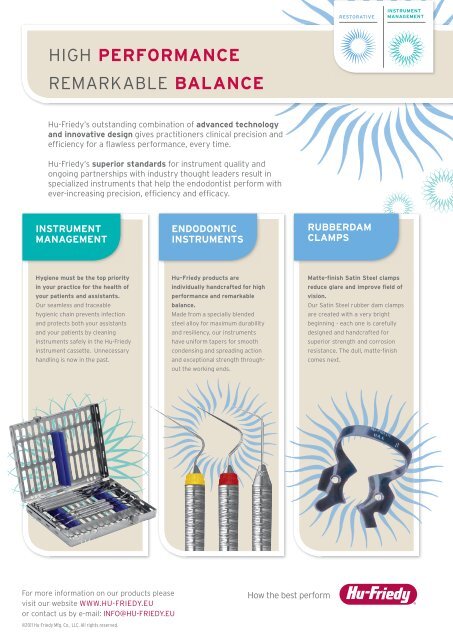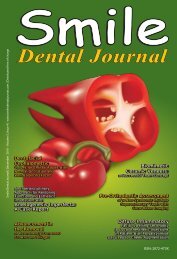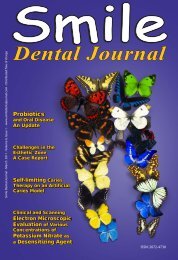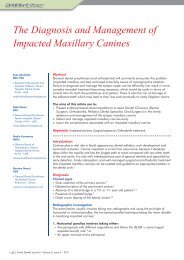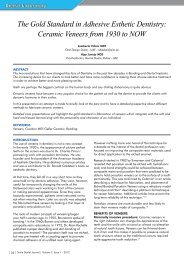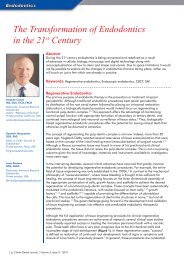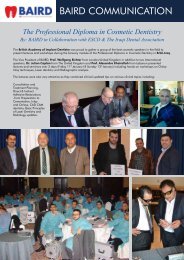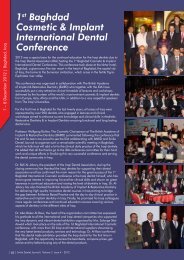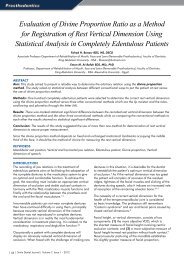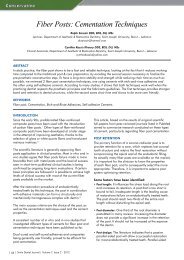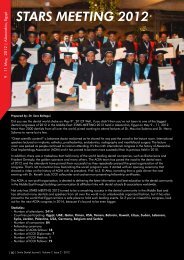Download e-copy - Smile Dental Journal
Download e-copy - Smile Dental Journal
Download e-copy - Smile Dental Journal
You also want an ePaper? Increase the reach of your titles
YUMPU automatically turns print PDFs into web optimized ePapers that Google loves.
60<br />
55<br />
50<br />
45<br />
40<br />
35<br />
30<br />
Frequency 25<br />
Percentage 20<br />
15<br />
10<br />
5<br />
0<br />
Asymmetry<br />
(Cheek Flattening)<br />
Limitation mandibular<br />
movement<br />
Deformity of<br />
orbital rim<br />
Deformity of<br />
Z-F Suture<br />
Infra-orbital<br />
paraesthesia<br />
(Fig. 9) Persistent complications of zygomatic-complex fractures<br />
The most frequent complication of zygomatic complex<br />
fractures was infra-orbital paraesthesia in 27 cases<br />
(54%). This was followed by 3 cases (6%) in asymmetry<br />
(cheek flattening). Two cases (4%) had limitation of<br />
mandibular movement. Persistent diplopia and changes<br />
of visual acuity was seen in one case (2%) (fig. 9).<br />
Conclusion<br />
This study presents information that can be<br />
valuable in describing the pattern and spectrum<br />
of zygomaticomaxillary complex fractures in local<br />
population. Since the assault, the leading cause of facial<br />
trauma, are usually associated with greater severity of<br />
injuries, treatment approach needs to be comparatively<br />
aggressive e.g. exposure of fracture sites and internal<br />
fixations, for better aesthetic and functional restoration.<br />
However, the four most important considerations<br />
in treating zygomatic complex fractures are proper<br />
reduction, adequate stabilization, adequate orbital<br />
floor reconstruction (when necessary), and adequate<br />
handling/positioning of periorbital soft tissue which will<br />
provides the most accurate and satisfactory postoperative<br />
results. Variance in treatment may exist because therapy<br />
depends upon the type and severity of fracture, the time<br />
since injury, and the surgeon’s personal experience. The<br />
prognosis of zygomatic complex fractures is influenced<br />
by delay between time of injury and treatment. The<br />
timing of surgery is dependent on the general health<br />
of the patient and the presenting signs and symptoms.<br />
Ideally management of zygomatic complex injuries<br />
should be undertaken after residual oedema has<br />
subsided and a thorough pre-operative ophthalmic<br />
assessment has been performed. As revealed in this<br />
study, only 72% of patients received surgical intervention<br />
to treat their injury.<br />
References<br />
1. Hollows P, D’Sa A, McAndrew PG. Life-threatening heamorrhage<br />
after elevation of a fractured zygoma. Br J Oral Maxillofac Surg.<br />
1999;37:448-50.<br />
2. Israr N, Shah AA. Retrospective study of zygomatic complex<br />
fractures in Sheffield England. Pak Oral Dent J. 2001;21:50-9.<br />
Diplopia<br />
Loss of<br />
Visual Acuity<br />
3. Mackinnon CA, David DJ, Cooter RD. Blindness and sever visual<br />
impairment in facial fractures: An 11-year review. Br J Plast Surg.<br />
2002;55:1-7.<br />
4. Tadji Armin MB, Kimble Frank W. Fractured Zygomas. ANS. J. Surg.<br />
2003;73:49-54.<br />
5. Rowe, N.L, Killey, H.C. Fractures of the facial skeleton. Edinburgh,<br />
E & S. Livingston. Ed.1. 1955;328-59.<br />
6. Haider Z. Fractures of the zygomatic complex in the south-east<br />
region of Scotland. Br. J. Oral. Surg. 1977;15:265-7.<br />
7. Balle V, Christensen PH, Greisen O, Jorgensen PS. Treatment<br />
of zygomatic fractures: a follow-up study of 105 patients.<br />
Otolaryngolog. 1982;7:411-6.<br />
8. Telfer MR, Jones GM, Shepherd JP (1991).Trends in the aetiology of<br />
maxillofacial fractures in United Kingdom. (1977-1987). British. J.<br />
Oral & Max-Fac. Surg. 1982;29:250-5.<br />
9. Ogden GR. The Gillies method for fractured zygoma: an analysis<br />
of 105 cases. J. Oral. Max-Fac.Surg. 1991;49:23-5.<br />
10. Ellis E 3rd, el-Attar A, Moos KF. An analysis of 2,067 cases<br />
of zygomatic orbital fractures. J. Oral Max-Fac. Surg.<br />
1985;43(6):417-28.<br />
11. Cramer, L.Tooze, F., Lerman, S. Blow-out fractures of orbit. Br. J.<br />
Plast. Surg. 1965;18:171-9.<br />
12. Kristeensen S, Tvetrs K. Zygomati Fractures: Classsification and<br />
Complications. Clin. Otolarng. 1986;11:123-9.<br />
13. Larsen OD, Thomsen M (): Zygomatic Fractures. II. A Followup<br />
study of 137 patients. Scand. J. Plast. Reconstr. Surg.<br />
1978;12(1):59-63.<br />
14. Hollier, Larry H, M.D, Thornton James, M.D; Pazimiono, Pat M.D.;<br />
Stal, Samuel M.D. The Management of Orbito-zygomatic fractures.<br />
Plast Reconstr. Surgery. 2003;111(7):2386-93.<br />
15. Wiesenbaugh Josph M. Diagnostic evaluation of zygomatic<br />
complex fractures. <strong>Journal</strong> of oral surgery. 1970;28:204-8.<br />
16. Kaasted E, Freng A.Zygomatico-maxillary fractures. J.<br />
Craniomaxillo-facial Surgery. 1989;17:210.<br />
17. Carr RM, Mathog RH. Early and delayed repair of orbito-zygomatic<br />
fractures. J. Oral. Max-Fac. Surg. 1997;55:253-9.<br />
18. Zachariades N, Papavassiliou D, Papadenetrion I. The alteration<br />
in sensitivity of the infraorbital nerve following of the zygomatic<br />
maxillary complex. <strong>Journal</strong> Cranio-Max-Fac. Surg, 18:315-318.<br />
19. Kovacs and M. Ghahremani (2001). Minimization of zygomatic<br />
complex fracture treatment. Int <strong>Journal</strong>. Oral Max-Fac Surgery.<br />
1990;30(5):380-3.<br />
20. Covington DS, Wainwright. DJ, Teichgraeber JF et al. Changing<br />
patterns in the epidemiology and treatment of zygoma fractures:<br />
10-year review. <strong>Journal</strong> of Trauma. 1994;37:243.<br />
21. Knight, J.S. & North, J.F. The classification of Malar Fractures: An<br />
analysis of Displacement as a Guide to Treatment. Br. J. Plast Surg.<br />
1961;13:325-39.<br />
22. Folkestad Lena, MD, Granstrom Gosta, MD. A prospective study of<br />
orbital fracture squeals after change of surgical routines. J. Oral.<br />
Max-Fac, Surg. 2003;61:1038-44.<br />
23. Barclay TL. Diplopia in association with fractures involving the<br />
zygomatic bone. Br. J. Plast Surg. 1958;11:47.<br />
24. Zing M, Laedrach K, Chen J et al. Classification and treatment of<br />
zygomatic fractures: A review of 1,025 cases. J. Oral. Max-Fac.<br />
Surg. 1992;50:778.<br />
25. Chen CT. Chen YR. Endoscopically assisted repair of orbital floor<br />
fractures. Plast Reconstr. Surg. 2001;108:2011-8.<br />
26. Manson PN, Iliff N, Bradely R. Trapdoor fractures of the orbit in<br />
pediatric population. Plast Reconstr. Surg. 2002;109:490-5.<br />
27. Manolidis S, Weeks BH, Kirby M, M. Hollier. Classification and<br />
surgical management of orbital fractures: Experience with 111<br />
orbital reconstru- ctions. J. Craniofacial Surg. 2002;13: 726-37.<br />
28. Wray RC, Holtman B, Ribaudo JM, et al. A comparisons of<br />
conjunctival and subciliary incisions for orbital fractures.Br. J. Plast.<br />
Surg. 1977;30(2):142-5.<br />
29. Pospisil OA, Fernando TD (1984). Review of the lower<br />
blepharoplasty incision as a surgical approach to zygomaticoorbital<br />
fractures Br. N J. Oral. Max-Fac.<br />
30. Holtman B, Wray RC, Little G. A randomized comparison of four<br />
incisions for orbital fractures. Plast Reconstr. Surg. 1981;67:731-5.<br />
31. Jordan DR, Allen LH, White J, Harvey J, Pashby R, Esmaeli B.<br />
Intervention within days for some orbital floor fractures: the whiteeyed<br />
blow-out. Opthal. Plast Reconstr Surg. 1998;14:379-90.<br />
| 36 | <strong>Smile</strong> <strong>Dental</strong> <strong>Journal</strong> | Volume 6, Issue 4 - 2011


